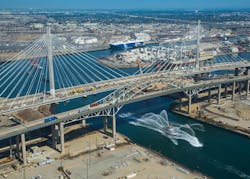Gerald Desmond Bridge replacement project opens to traffic in California
A ceremonial opening of California’s first cable-stayed bridge—which was constructed to replace the Gerald Desmond Bridge in the Port of Long Beach—took place a few days ago.
Long Beach Mayor Robert Garcia dedicated the structure, which is a 515-ft-tall, two-tower span that provides an important starting point for national cargo movement and a much-improved transportation link for commuters in coastal communities of Los Angeles and Orange counties.
The six-lane, nearly 2-mile-long bridge opens to traffic Monday morning, marking the end of a nearly 10-year, $1.47 billion effort to replace the 52-year-old Gerald Desmond Bridge, which was too narrow and too low to accommodate today’s roadway cargo traffic demands and the larger cargo ships that began arriving at the Port of Long Beach years ago. The Port of Long Beach says the lower Desmond Bridge was nearing of its expected lifespan, and needed to be replaced to provide a long-term, reliable connection to Terminal Island. More than 15% of the nation’s imported container cargo travels over this bridge route.
The new bridge was jointly funded by the Port of Long Beach, Caltrans, the U.S. DOT, and Los Angeles County Metropolitan Transportation Authority (Metro).
“This new bridge is another major milestone in the Port’s ongoing commitment to remain the most advanced and most competitive port in the world,” Mario Cordero, Executive Director of the Port of Long Beach, said in a statement. “It is much more than a convenient roadway. It is a critical link in the global movement of cargo. It is a bridge to everywhere.”
With the highest deck of any cable-stayed bridge in the U.S., the new bridge is designed to last 100 years with minimal maintenance and considered one of the most seismically advanced structures in the country, according to the Port of Long Beach. The bridge includes German-design joints at each end of the main span that move up to 6 ft in three directions during a very strong earthquake. These joints, large dampers, and other features are designed to provide flexibility and elastic points of isolation that enable bridge segments to move independently without causing significant damage to the bridge’s primary superstructure.
The new bridge features 18 million lb of structural steel, 75 million lb of rebar, and 1.7 million ft of cable. If laid end-to-end, the cables would stretch about 322 miles—longer than the distance from Long Beach to Las Vegas.
With 80 cable strands holding the center span and column-supported approach lanes featuring more efficient ramps and turning lanes, the new bridge will provide an efficient transition to and from the southern terminus of the 710 Freeway at the east end of this major transportation link, and an integrated connection to State Route 47 and Terminal Island at the west end. The project features California’s first-ever “Texas U-turn,” a non-signaled undercrossing that enables continuous travel for trucks and cars.
--------
SOURCE: Port of Long Beach
